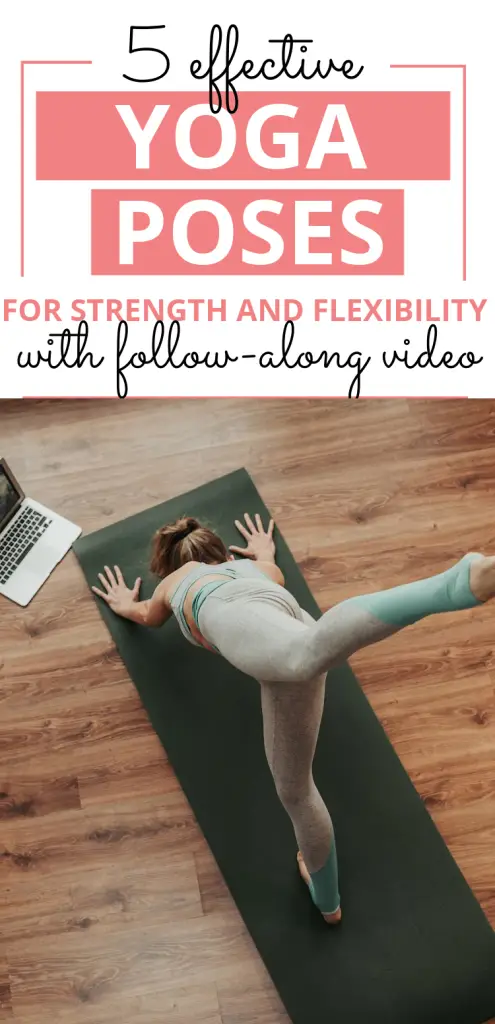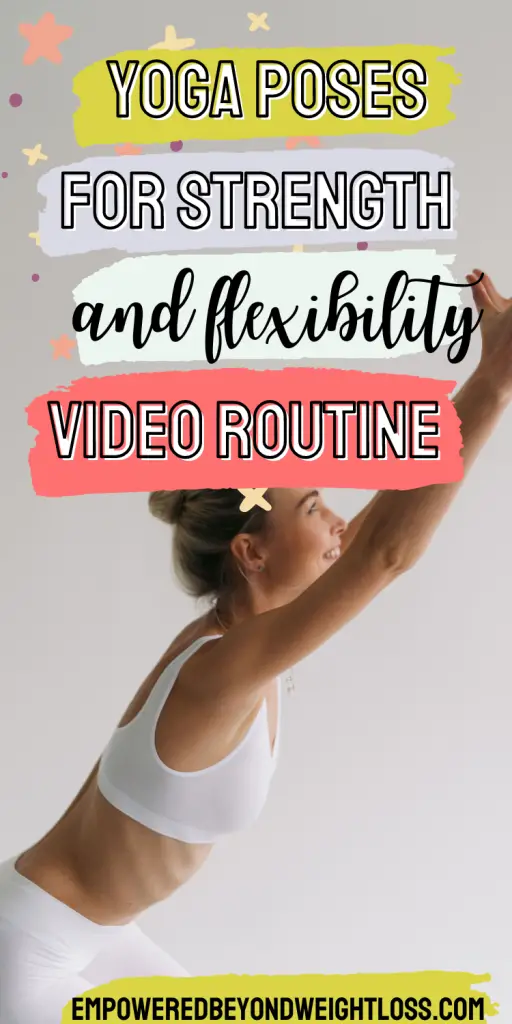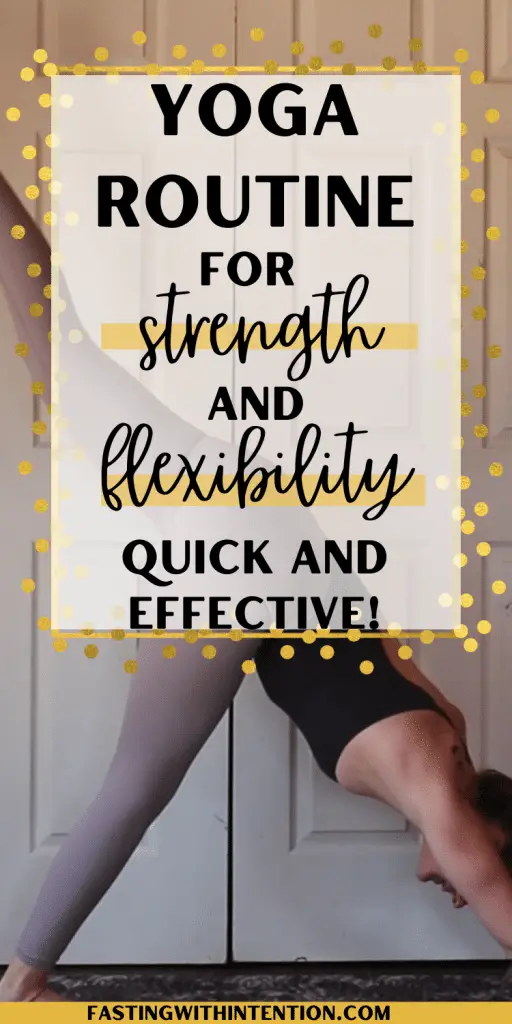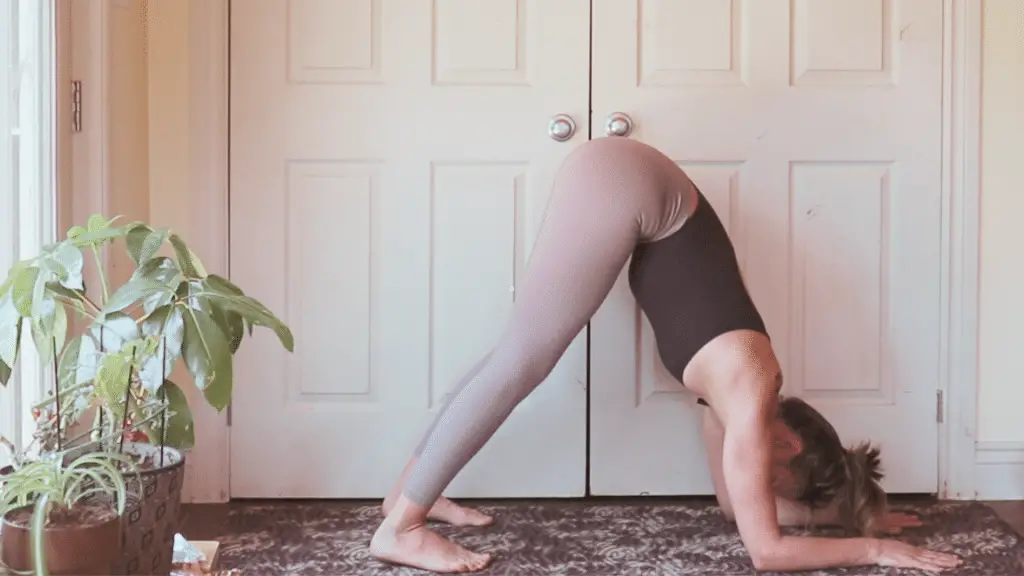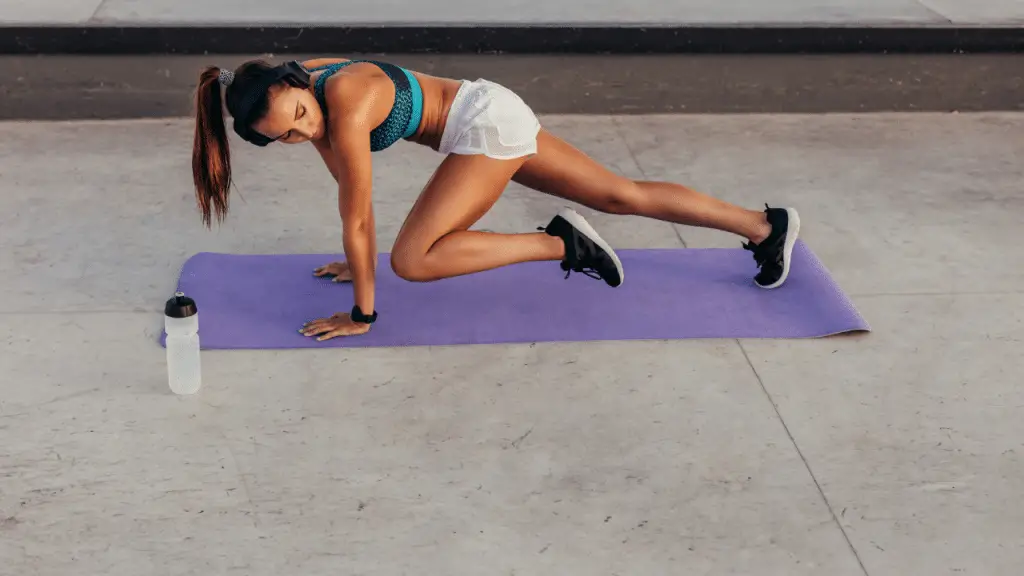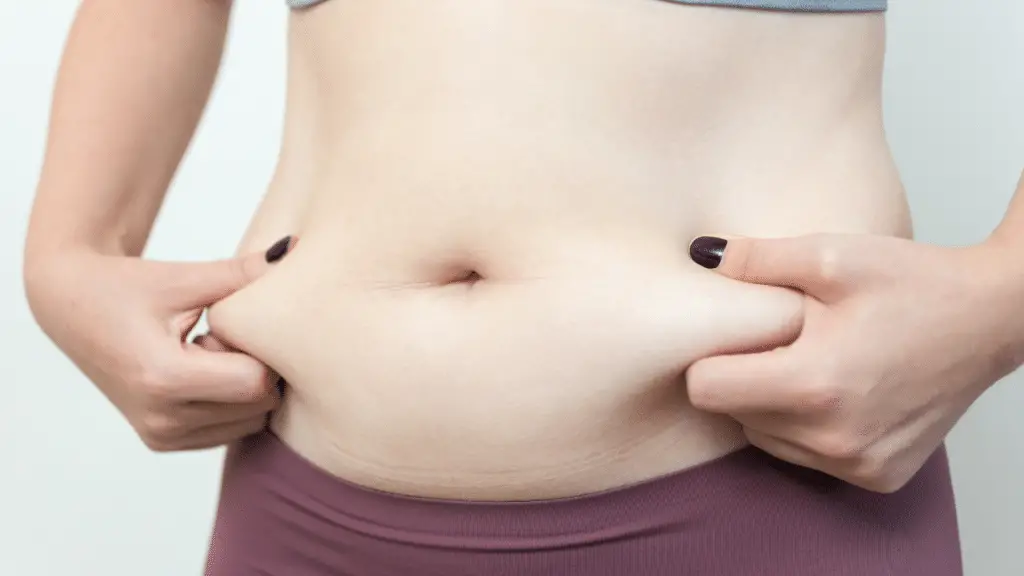As you look at some of my favorite yoga poses for strength and flexibility, I will take you along through a video routine you can follow to get strong and flexible in the least amount of time possible. I love helping women over 40 discover the benefits of yoga and get in the best shape of their lives doing so. Let’s get started!
Yoga Poses for Strength and Flexibility
There are many more than five yoga poses that are beneficial to improving your strength and flexibility. I simply picked my favorite ones. if you are a beginner, check out my post 10 Yoga Poses for Flexibility for Beginners . That said, you can still do the following yoga routine for strength and flexibility. as I offer some modifications.
1. Standing Splits (or Three-Legged-Dog)
I attempted the standing splits for the first time years ago while doing an online pilates class. I couldn’t get anywhere close to a standing split. I didn’t understand how regular women like me could even do something like that. Fast forward 10 years, and now, I can do the splits on the ground, so the standing splits are no longer this unachievable pose. The standing splits require strength, mobility, and flexibility. If you lack flexibility like I did in my thirties, you can work on that. When you follow my video routine, just take your leg as high as you can or work on your three legged-dog). Don’t judge yourself! Improving your strength and flexibility will get you there eventually!
Use my free splits video to improve your flexibility, or consider purchasing my Flexibility Transformation program. My Full-Body Flexibility Program is the Ultimate step-by-step yoga for flexibility and strength for beginners Program.
Stage one focuses on building your flexibility gradually for the splits. Stage two includes backends to your training schedule and stage three adds in the more advanced yoga poses for flexibility like King Pigeon and the standing splits.

2. King Dancer
I find King Dancer pose absolutely beautiful! I think one fundamental reason I enjoy yoga is the artistic side of it. Many yoga poses are impressive as they require strength and flexibility but also look aesthetically pleasing to me. King Dancer is one of them.
I created a follow-along for the King Pigeon, which is a helpful introduction to increase your flexibility before King Dancer.
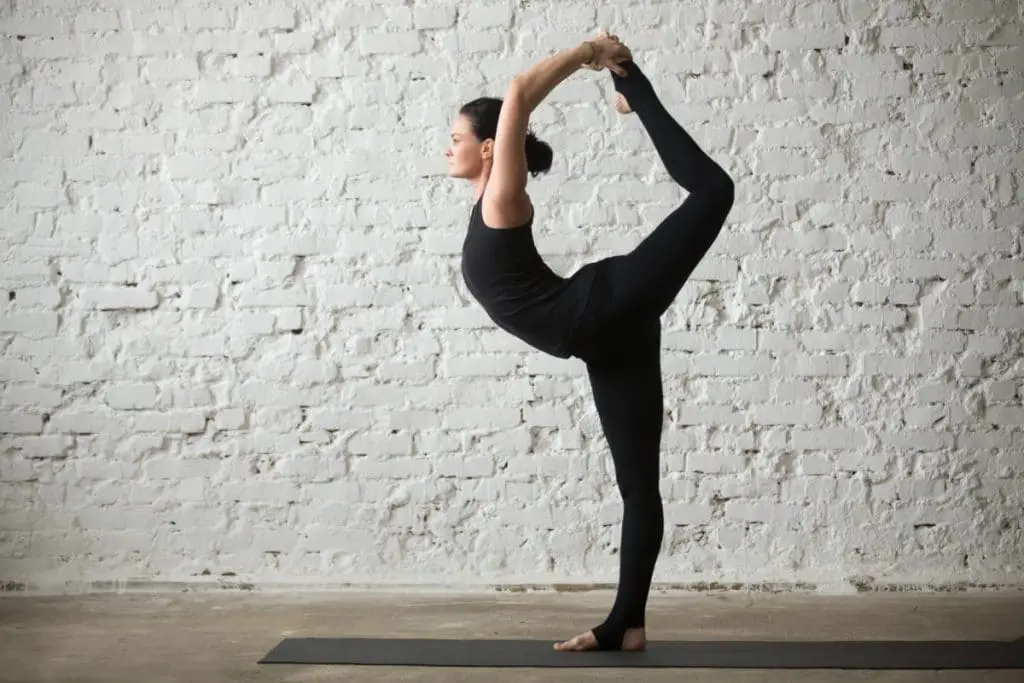
3. Wheel
Not all little children can do the splits, but all little children can do a deep wheel. As an adult, you may find the wheel incredibly challenging (I couldn’t even lift myself up on the crown of my head at first). Still, you will discover that increasing your back flexibility is much faster than gaining enough flexibility to achieve the splits.
Moreover, the wheel is an energizing pose. Once you manage to get up there. You will notice that it makes you feel happy and energetic. It improves your posture and reduces your risk of back issues.
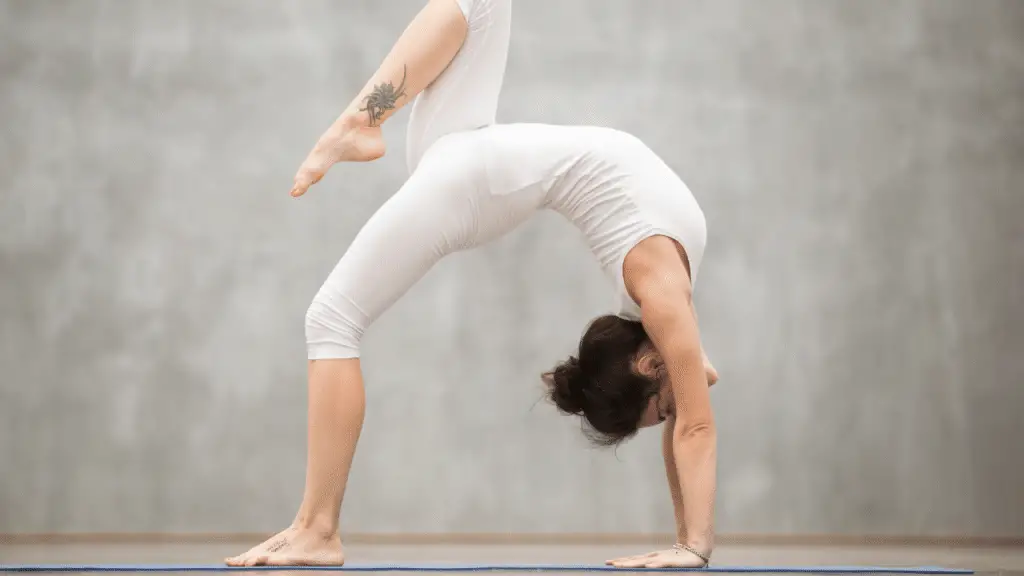
4. Crescent Lunge
The crescent lunge is another effective strength and flexibility yoga pose. It requires strength and flexibility in the legs as well as flexibility in your back body. I love using it to prepare for the wheel as well as the splits.
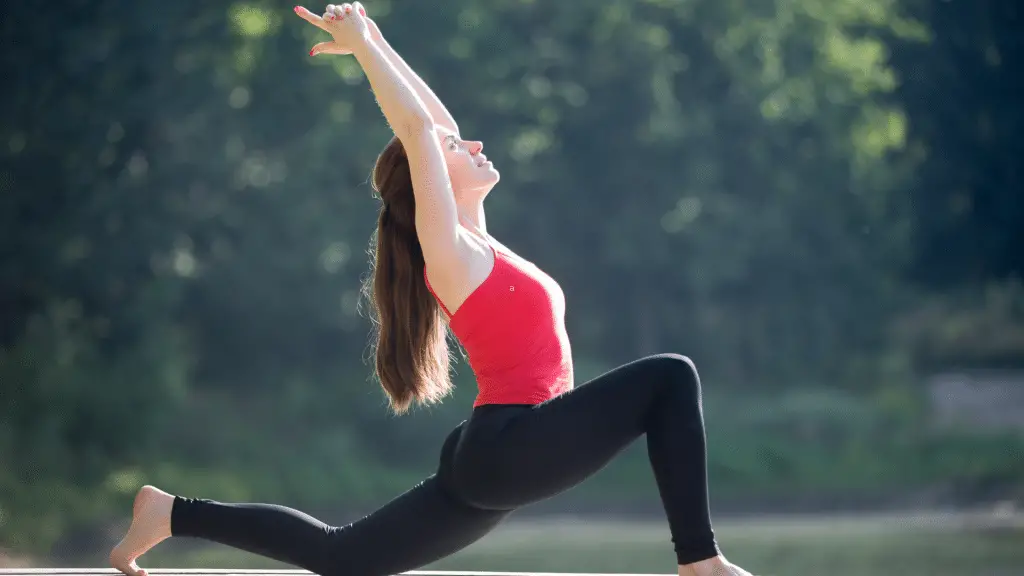
5. Skandasana (Wide-Legged Squat Over One Leg)
The last yoga pose for strength and flexibility that I wanted to mention in today’s post is skandasana. Skandasna is amazing for leg strength and flexibility and you can even use it to get a bit of a cardio workout when you move actively from side to side.
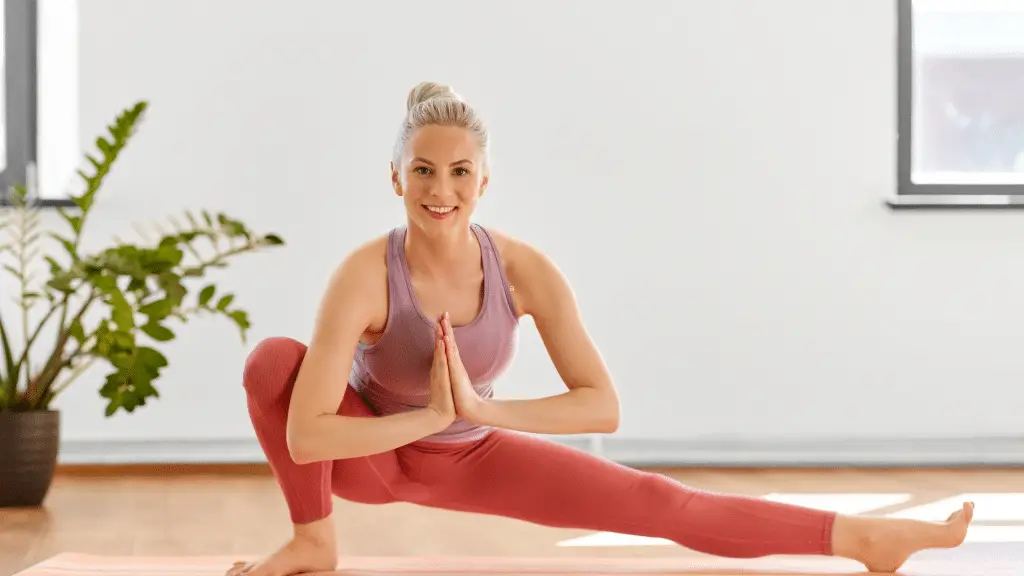
Yoga Poses for Strength and Flexibility Routine
This yoga routine for strength and flexibility includes most of my favorite poses for strength and flexibility. Instead of the wheel, I used the dolphin pose, which is incredibly effective in increasing your arms and shoulder strength in preparation for achieving the wheel. It is a super quick routine that beginner and intermediate yogis alike will love.
How Does Yoga Improve Flexibility?
Yoga improves your flexibility by requiring you to stay in positions that require flexibility for long enough to signal your central nervous system that these positions are safe. I go more into depth about how improving your flexibility works in my post Am I Too Old To Be Flexible?
Does yoga increase strength or flexibility?
As you will find out below, there are multiple studies that show that yoga increases your strength and flexibility. In fact, it doesn’t end there. It also increases your cardiorespiratory endurance, balance, and mindfulness. You can even practice yoga for weight loss (including restorative yoga).
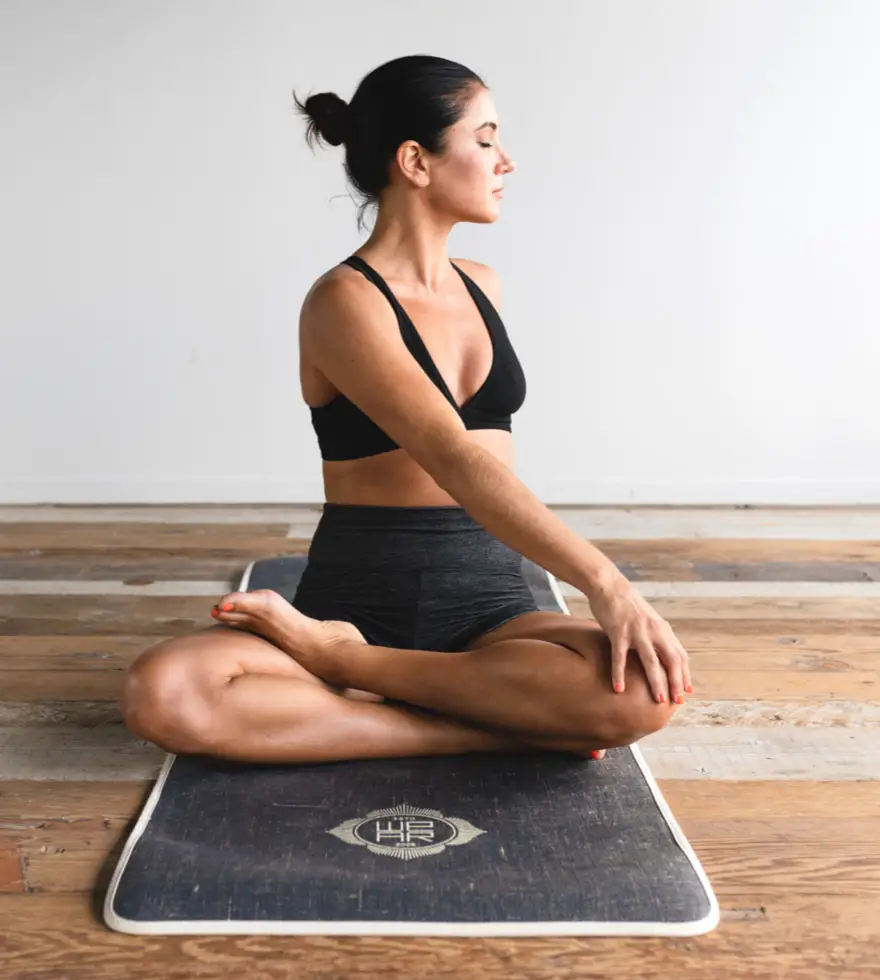
What type of yoga is best for strength and flexibility?
I have a few tips for picking the type of yoga that will benefit you most if you want to work on your flexibility. First of all, let’s revisit some of the types of yoga that I mention in my post Starting Yoga At 40 Or Later: Everything You Need To Know.
- Hatha: Hatha yoga tends to be slower and more gentle. You will be holding some basic yoga poses in sequence.
- Ashtanga: With Ashtanga yoga, you will follow specific sequences to challenge your strength, endurance, and flexibility. It will also require more focus as you practice following your breath.
- Vinyasa: Vinyasa yoga is similar to Hatha yoga in that it strings different poses together. However, the pace of Vinyasa yoga is faster, and it emphasizes connecting your breath to your movements. Vinyasa yoga is less intense than Ashtanga yoga as it typically doesn’t challenge your endurance as much.
- Yin: Yin yoga is a much slower type of yoga. Typically, you will hold the poses for anywhere between 3-5 minutes.
- Restorative: Both yin and restorative yoga require you to stay in poses for a few minutes. However, restorative yoga uses props to keep you comfortable. The purpose of restorative yoga is to calm the central nervous system. Yin yoga may be used to increase your flexibility so that you will experience some discomfort.
I found a 12-week study that looks at the Effect of Hatha Yoga on Cardiorespiratory Endurance, Muscular Strength, Endurance and Flexibility. The yoga groups achieved significant improvements in flexibility. You could improve your strength and flexibility using most types of yoga, but yin is my favorite to improve my flexibility, and vinyasa for improving both strength and flexibility.
Yoga for Flexibility and Balance
What I find remarkable about yoga is how multipurpose it is. It will improve your strength, flexibility, endurance, balance, and mindfulness. It is such a healing exercise! Even athletes who are training for a different sport can benefit from yoga. According to this 10-week study, athletes who practice yoga will significantly increase their flexibility and balance. Really, why would anyone not want to practice yoga? I can think of a few reasons, but I address them in my post Uncover 11 Myths About Yoga You Can Stop Believing Now.
Summary
Yoga is a holistic practice that has been around for thousands of years and has been proven to provide numerous benefits to both the mind and body. One of the primary benefits of yoga is increased strength and flexibility, which can significantly improve one’s quality of life.
Strength and flexibility are two essential components of physical fitness and are necessary for maintaining good posture, reducing the risk of injury, and enhancing overall mobility. While traditional strength training exercises such as weightlifting or bodyweight exercises can help build muscle, they often neglect flexibility, which is where yoga comes in. Yoga is designed to work both the muscles and the connective tissues, improving flexibility and increasing strength at the same time.
Yoga is a low-impact form of exercise that is suitable for people of all ages and fitness levels. It involves a combination of physical postures, breathing techniques, and meditation practices that help to improve one’s physical and mental health. Yoga poses, or asanas, are designed to work different muscle groups in the body, building strength and flexibility over time.
One of the benefits of yoga is that it is customizable to suit each individual’s needs and fitness level. For those looking to increase strength, plenty of challenging poses can be practiced to build muscle mass, such as Warrior Pose, Chair Pose, and Downward-Facing Dog. These poses target specific muscle groups, such as the legs, arms, and core, building strength and endurance over time.
For those looking to improve flexibility, yoga offers a wide range of poses that are designed to stretch and lengthen the muscles and connective tissues. For example, Pigeon Pose, Lizard Pose, and Half Pigeon Pose are excellent for stretching the hips and legs, improving flexibility, and reducing the risk of injury. Stretching is an essential aspect of yoga, as it helps increase circulation and reduce muscle tension, improving flexibility and reducing the risk of injury.
In addition to the physical benefits of yoga, the practice also offers numerous mental and emotional benefits. Regular yoga practice can help to reduce stress, anxiety, and depression and improve overall well-being. Yoga helps to promote mindfulness, which is the practice of being fully present in the moment and focusing on one’s breath and body sensations. This mindfulness can lead to an increased sense of calm, which can improve one’s quality of life.
In conclusion, yoga is a holistic practice that provides numerous benefits for both the mind and body. The practice can significantly improve strength and flexibility, reduce the risk of injury, and enhance overall mobility. Whether you are a beginner or an experienced yogi, yoga offers a wide range of benefits that can improve your physical and mental health. So, why not give it a try and experience the numerous benefits of yoga for yourself?
